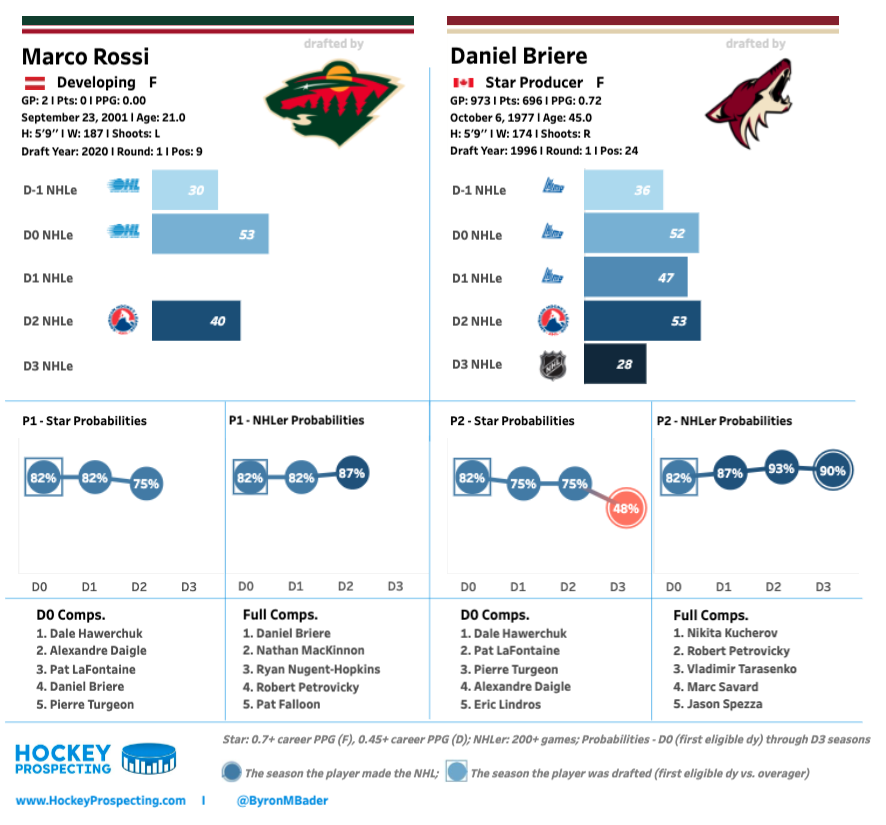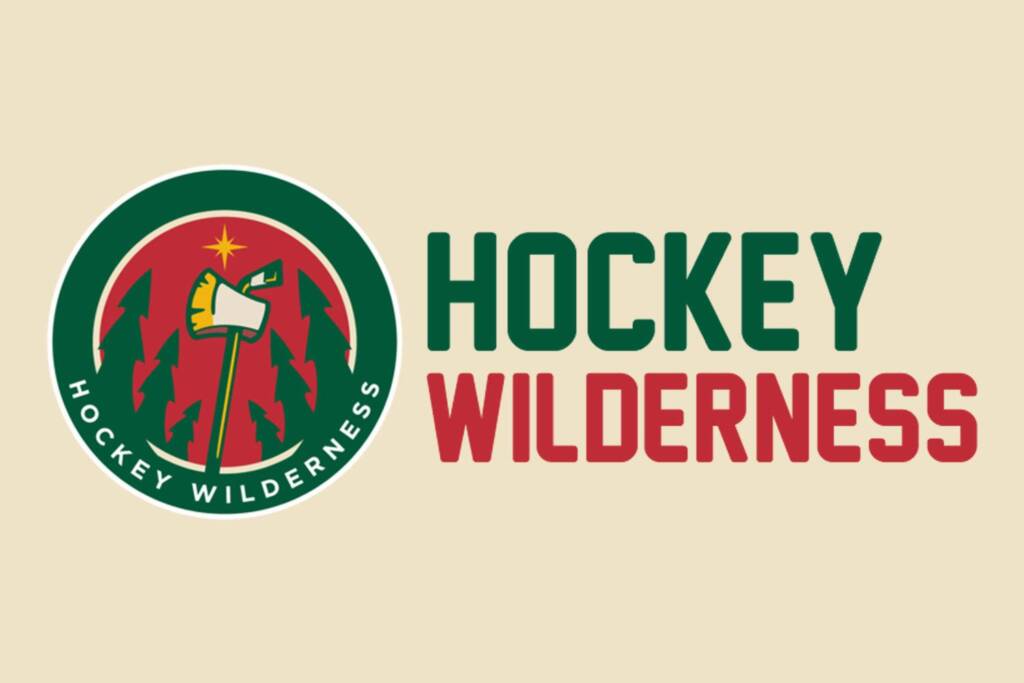Pinning a big chunk of your hopes on a 21-year-old kid being good is usually not a great sign in the NHL. Sure, if that 21-year-old kid is a generational talent like Alex Ovechkin or Connor McDavid? Yeah, that works, but for anyone not quite at that level? That’s a lot of weight to put on a young player trying to break into the league.
The Minnesota Wild are coming off a breakthrough 113-point season and hungry for postseason success after failing to advance for six years in a row. Losing Kevin Fiala, an 85-point scorer, is a big blow to an otherwise up-and-coming team.
No one in the organization will say it, but with no offseason moves to offset Fiala’s loss, their eggs of replacing those 85 points fall almost entirely in Marco Rossi’s basket. Or, at the very least, replace Fiala as a dynamic threat to complement Matt Boldy. Rossi got 63 AHL games last year, but these are massive shoes to fill immediately.
But, we may forget that asking Rossi to rise to a massive challenge was always part of Minnesota’s plans. Remember that the Wild never intended to rock Victor Rask as their top center in the COVID-shortened 2020 season. That spot appeared reserved for Rossi, straight out of the draft.
There’s an alternate universe where Rossi grabs that spot at age 19 and is off this list entirely because he’s 130 games or so into an NHL career. Alas, we know the story of him getting myocarditis from COVID, which pushed his timetable back two seasons.
In between, there’s just enough time for some buyer’s remorse to kick in. Three picks after Rossi, the Florida Panthers drafted Anton Lundell. While Rossi toiled in Des Moines, Lundell had a brilliant rookie campaign, scoring 18 goals and 44 points in 65 games as a third-line center.
Lundell played on a change-of-pace line, joining Sam Reinhart and Mason Marchment to push the offense outside Florida’s Top-6. Had Lundell been in Minnesota, he could’ve done the exact same thing, but between Boldy and Fiala.
Alas. As it stands, Rossi was in the AHL for a combination of taking it slow after a tough injury and salary cap manipulation. What weighed into the decision more? That’s up to you to guess. Rossi was limited to two NHL games, where he scored zero points and was overshadowed by Boldy’s excellence.
Two games shouldn’t weigh into anyone’s evaluations, except that it was the only look most Wild fans got at Rossi. Few in the State of Hockey are cool on him, but it does seem the hype train isn’t full-steam ahead. According to a fan survey by The Athletic in June, over half (52.3%) of about 5,000 Wild fans believe Rossi will experience growing pains this season.
Rossi’s also been out-of-sight, out-of-mind a bit on the national stage as well. Scott Wheeler of The Athletic ranked Rossi 16th on his recent Top-50 list of drafted prospects. 16th is great! But after the 2020 Draft, before the myocarditis, Wheeler placed Rossi placed third.
He must make up for some lost time to re-establish himself as an elite prospect/young player in the league. The 10K Rinks staff believes he can. Rossi received five of the seven first-place votes — the other two went to Wallstedt.
Why are we so confident? In some ways, the stats speak for themselves. Rossi posted one of the most prolific draft seasons we’ve seen, scoring 120 points in 63 OHL games. After a year off, he immediately stepped onto the ice and racked up 53 points in 63 games while jumping straight into the AHL.
He was fourth on the Iowa Wild in goals (18) and tied with Kyle Rau with 53 points. Among all AHL rookies, he finished 15th and seventh in those two categories, respectively, while also finishing 11th with 157 shots on goal.
Leave aside the fact that he was one of the youngest AHLers. Don’t even think about what he had to overcome to get to that point after a year on the shelf. Just look at the track he’s on just from raw numbers alone.
Is it good when your two biggest comparables are Daniel Briere and Nathan MacKinnon? Briere averaged 28 goals and 62 points per 82 games in the three seasons before the 2004-05 lockout. After the lockout, where rules changed to allow smaller players to shine, he exploded. From ages 28 to 33, Briere averaged 34 goals and 78 points per 82 games.
We trust you to remember who three-time Hart Trophy Finalist Nathan MacKinnon is. He averages 32 goals per 82 games over his career and is a career point-per-game guy. You want to see those names when looking at your top prospect’s comparables. And those aren’t opinions or a prospect being overhyped. Those are just numbers.
Now let’s include all the context the numbers missed. Namely, he missed a year of hockey before immediately being the best player on the Iowa Wild. Even more interestingly, Rossi started the season at an even better pace.
In his first 35 games, Rossi wasn’t just playing well in the AHL. He destroyed it. Rossi had 14 goals and 38 points in that stretch, meaning he wasn’t just competing with the league’s top rookies. If he finished his season at that 1.09 point-per-game pace, he’d have been in the AHL’s top-20 or 25 producers at just age 20.
Then he seemingly ran out of steam, scoring just four goals and 15 points over his final 28 games. What happened, and should Wild fans worry?
Probably not, and here’s why. Remember, Rossi didn’t only not play for a year. Part of Rossi’s recovery from myocarditis required keeping his heart rested, meaning he couldn’t train. From January to mid-May, his exercise was limited to short walks and light mobility training. He couldn’t skate until June.
Usually, injured players can do some form of exercise to avoid muscle loss and atrophy, but the nature of Rossi’s condition meant he couldn’t. Now, he built back enough strength to play four great months of hockey, but maybe not enough to power through a full 60-game season at the highest level.
This hurts doubly because strength is one of Rossi’s biggest weapons on the ice. That sounds kind of silly, talking about a 5’9″ player who doesn’t hit much, but it’s true. His explosiveness and agility come from his quads, which at full health are thick enough to crush a bus into a 5’x5′ cube. That leg strength keeps his center of gravity low, making Rossi tough to knock off the puck and unrelenting on defense.
He has that full offseason to train and doesn’t have to start back at square one. When 10K Rinks asked Rossi about this difference in training camp, he said, “Last year was a short time to prepare for the season. Maybe four-to-six weeks after five months of doing nothing, so that was really hard. And this year, I have way more time to get better off the ice and prepare myself for the season more.”
We know he’ll put in the work this offseason. His path is also fairly clear, as he has a great shot at landing a big-time role next to Boldy, who showed great chemistry with Rossi at training camp and Iowa last year. After two trying years, Rossi will finally get a great shot at succeeding in an NHL role. Expect him to make up for those lost two years, starting soon.


